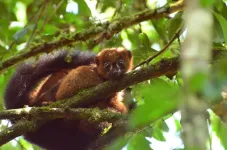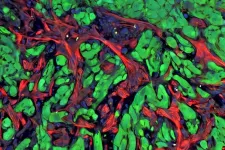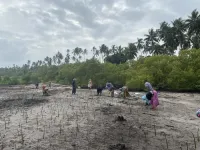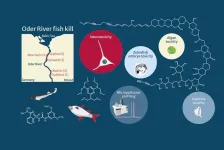(Press-News.org) Conservation efforts directed towards just 0.7% of the world’s land mass could help protect one third of the world’s threatened and unique tetrapod (four-limbed vertebrate) species, new research by Imperial College London, On the Edge, and ZSL has shown.
The study, led by researchers at Imperial College London and published this week in Nature Communications, finds that large gains in conservation are possible by focusing on areas home to exceptional biodiversity and species with high levels of evolutionary distinctiveness and global endangerment.
These endangered species include animals like the aye-aye, a highly distinctive lemur found in Madagascar; the long-legged and eagle-bodied secretary bird; the purple frog, which has a nose similar to a pig; and the gharial, a long-snouted and critically endangered crocodile found in the Indian subcontinent.
At present, however, just 20% of the areas identified in the study are under some form of protection, with most areas facing consistent and increasing levels of human pressure.
Lead author Sebastian Pipins, a PhD candidate at the Grantham Institute, Imperial College London, said: “Our research highlights the regions of the world that are of immediate concern. Furthermore, it shows that in protecting just a fraction of the Earth’s land surface, huge gains can be made for the preservation of nature.”
On the edge of extinction
The project identified specific areas of conservation interest with exceedingly high levels of threatened evolutionarily history that are marked by their concentration of Evolutionarily Distinct (ED) and Globally Endangered (GE) species.
Evolutionary distinctiveness quantifies how unique a species is, with some being the result of long periods of unique evolutionary history with few or no close living relatives. Meanwhile, global endangerment reflects the extinction risk of a species. Species that score highly on both measures are known as EDGE species, while the areas in which these species are found in high concentrations are referred to as EDGE Zones.
Pipins added: “It is crucial to not just consider species diversity in conservation efforts, but also the evolutionary history of diversity, to ensure that large and unique branches from the tree of life are not lost.”
Zones of interest
The study mapped the distribution of almost 3,000 EDGE species, identifying 25 EDGE Zones where conservation efforts can have the greatest impact.
Specific areas of EDGE species richness include large parts of Southeast Asia and the Indo-Gangetic plain, the Amazon basin and the Atlantic Forest, as well as in Hispaniola, the highlands of Cameroon, and the Eastern Arc mountains of East Africa.
The authors found maximum richness within an area of less than 100-square kilometres in Madagascar, which, along with Mexico and Indonesia, contained the highest number of EDGE species.
Underlining the critical importance of national leadership to support conservation efforts, the research also found that 75.6% of EDGE species exist within a single country.
Co-author Dr Rikki Gumbs, from the ZSL’s EDGE of Existence programme, said: “Three-quarters of the world’s most unique animals are able to call only one country home, meaning that action from individual nations will go a long way to protect these incredible species from extinction.”
Very large areas of Southeast Asia have higher levels of EDGE species, which the researchers say reflects how the looming biodiversity disaster in this region is impacting the highly unique and wide-ranging species found within.
Human factors
The scientists also found that the vast majority of EDGE Zones face high levels of human disturbance and that the human populations found within many EDGE Zone countries face deprivation in education, health, and living standards.
Dr Gumbs added: “We’re currently in the midst of a biodiversity crisis, driven by unsustainable use of natural resources; it’s shocking but not surprising that 80% of the zones we identified are under high levels of pressure from human activity.”.
Given these challenges, governments’ limited resources are often prioritised for dealing with human deprivation, leaving less for biodiversity conservation.
Pipins said: “Given the global importance of the biodiversity found within these regions, high-income countries must mobilise funding to facilitate sustainable development that can benefit both humans and nature.”
Global goals
Just 20% of EDGE zones are under some form of protection. As countries look to protect 30% of land and sea by 2030, as per the Convention on Biological Diversity’s target, the authors call for the unprotected portions of EDGE Zones to be prioritised.
Dr Gumbs said: “With the COP16 Biodiversity Conference on the horizon, we need to see world leaders from across the globe scaling up their commitments and resources to support these efforts and restore the natural world that we all rely on.”
The researchers argue that their findings demonstrate that large gains of biodiversity are possible with relatively small additions to globally protected areas. They also argue that their research offers the potential for extending the EDGE Zone approach to other important groups of wildlife, such as plants and fish.
Using EDGE zone research
The EDGE Zones identified in this research will guide the activities of the charitable organisation On the Edge, directing their conservation grant-making, regional campaigns, and grantee-led storytelling.
They will also form part of the decision-making for resource allocation for ZSL’s EDGE of Existence programme, which has already funded work on over 50 EDGE species found within EDGE Zone countries, with a particular focus on the Gangetic Plains and Cameroon.
END
Protecting just 0.7% of world’s land could help save a third of most unique and endangered species
2024-09-06
ELSE PRESS RELEASES FROM THIS DATE:
TGF-beta and RAS signaling are both required for lung cancer metastasis, study finds
2024-09-06
When it comes to cancer metastasis, it takes two to tango. That was one of the key findings of a new study led by researchers at Memorial Sloan Kettering Cancer Center (MSK): The TGF-beta and RAS signaling pathways work together to spur the spread of cancer in lung adenocarcinoma, a leading cause of cancer deaths around the world.
Take away one of those two signals, and lung cancer will not be able to spread (metastasize) to new parts of the body, their findings in animal models suggest.
The research, published September 6 in Cell, points to new opportunities to potentially prevent metastasis, thanks to an updated understanding of the underlying processes.
“About ...
5 lessons to level up conservation successfully
2024-09-06
Conservation needs to scale successfully to protect nature. A new paper takes lessons from around the world to show how that might be done.
To reverse biodiversity loss and meet ambitious global targets, conservation programmes designed to preserve everything from forests to fish need to work ‘at scale’.
Scaling can mean three things. Scaling ‘out’ means expanding a programme to new people and places, while scaling ‘up’ means bringing in higher-level institutions, such as governments introducing policies or incentives that make it easier for individuals and private companies to engage.
Scaling ‘deep’ means changing hearts and minds – ...
Researchers advance new class of quantum critical metal that could advance electronic devices
2024-09-06
A new study led by Rice University’s Qimiao Si has unveiled a new class of quantum critical metal, shedding light on the intricate interactions of electrons within quantum materials. Published in Physical Review Letters on Sept. 6, the research explores the effects of Kondo coupling and chiral spin liquids within specific lattice structures.
“The insights gained from this discovery could lead to the development of electronic devices with extreme sensitivity, driven by the unique properties of quantum-critical ...
DOE, ORNL announce opportunity to define the future of high-performance computing
2024-09-06
The U.S. Department of Energy’s (DOE) Office of Science (SC) today announced a new research and development opportunity led by Oak Ridge National Laboratory (ORNL) to advance technologies and drive new capabilities for future supercomputers. This industry research program worth $23 million, called New Frontiers, will initiate partnerships with multiple companies to accelerate the R&D of critical technologies with renewed emphasis on energy efficiency for the next generation of post-exascale computing in the 2029 ...
Cannabidiol demonstrated to alleviate symptoms of Leigh syndrome
2024-09-06
A study led by the UAB Institut de Neurociències and published in the journal Nature Communications demonstrates in animal models how daily administration of cannabidiol (CBD), a substance obtained from the cannabis plant, extends lifespan and improves symptoms associated with Leigh syndrome. This severe mitochondrial disease affecting children is characterised by a progressive decline in cognitive and motor functions and premature death. The research group also demonstrated in both mice and fibroblasts from children with ...
A chemical cocktail of micropollutants amplified the effect of algal toxins causing mass fish mortality on the River Oder in 2022
2024-09-06
Summer 2022’s environmental disaster led to the death of up to 60 per cent of fish biomass and up to 85 per cent of mussel and snail biomass in the River Oder. In August 2022, the UFZ set up an interdisciplinary ad hoc working group together with researchers from the Leibniz Institute of Freshwater Ecology and Inland Fisheries (IGB), the University of Veterinary Medicine, Vienna (Vetmeduni) and the University of Birmingham. They took water samples at five locations along the Oder, extracted poisoned ...
Generative AI in cancer imaging: revolutionizing detection & diagnosis
2024-09-06
“This editorial explores its impact on expanding datasets, improving image quality, and enabling predictive oncology.”
BUFFALO, NY- September 6, 2024 – A new editorial was published in Oncotarget's Volume 15 on September 4, 2024, entitled, “Generative AI in oncological imaging: Revolutionizing cancer detection and diagnosis.”
Generative AI is revolutionizing oncological imaging, enhancing cancer detection and diagnosis. This editorial explores its impact on expanding ...
Disparity in access to medications for opioid use disorder persist in criminal legal settings
2024-09-06
EMBARGOED FOR RELEASE UNTIL 11 A.M. ET FRIDAY, SEPTEMBER 6. 2024
Individuals involved in the criminal legal system have a high rate of opioid use disorder (OUD) and a high risk of overdose death compared to the general population, yet the most effective treatments—medications for opioid use disorder (MOUD)—are underutilized in criminal legal settings where treatment is mandated as part of a person’s probation or parole. Medications are often not provided due to stigma or lack of adequate funding for evidence-based care. According to a study ...
Age-related changes in male fibroblasts increase treatment-resistant melanoma
2024-09-06
Age-related changes in the fibroblasts, cells that create the skin’s structure, contribute to the development of aggressive, treatment-resistant melanoma in males, according to research in mice by the Johns Hopkins Kimmel Cancer Center.
The study was published online Sept. 6 in Cell.
The risk of developing melanoma, a potentially deadly skin cancer, increases with age. Men are more at risk than women, and tend to develop more aggressive, hard-to-treat melanomas, particularly at advanced ages, says Ashani Weeraratna, Ph.D., the Bloomberg ...
COVID-19 and rates of cancer diagnosis in the US
2024-09-06
About The Study: This population-based cross-sectional study of U.S. cancer incidence trends found that rates of diagnosis improved in 2021 but continued to be lower than expected, adding to the existing deficit of diagnosed cases from 2020. Particular attention should be directed at strategies to immediately increase cancer screenings to make up lost ground.
Corresponding Author: To contact the corresponding author, Krystle A. Lang Kuhs, PhD, MPH, email krystle.kuhs@uky.edu.
To access the embargoed study: Visit our For The Media website at this link https://media.jamanetwork.com/
(doi:10.1001/jamanetworkopen.2024.32288)
Editor’s Note: Please see ...










